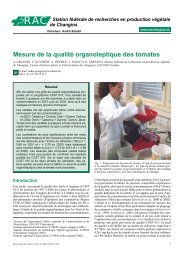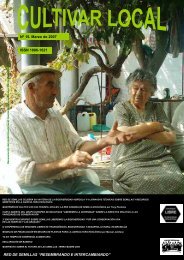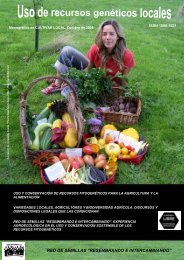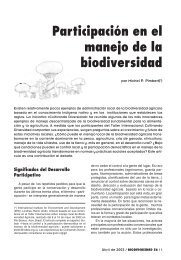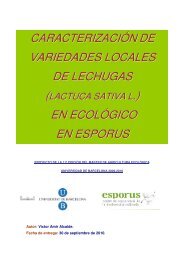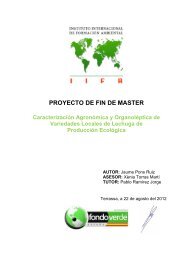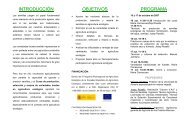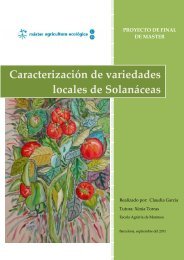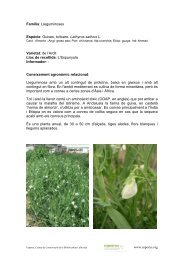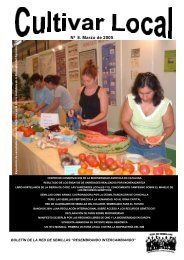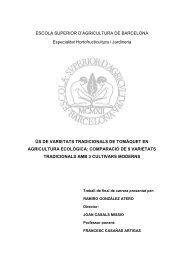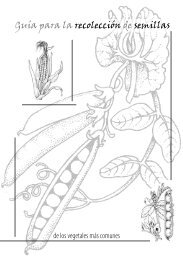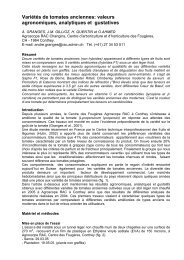Descriptores para el tomate - Esporus -- Centre de conservació de ...
Descriptores para el tomate - Esporus -- Centre de conservació de ...
Descriptores para el tomate - Esporus -- Centre de conservació de ...
Create successful ePaper yourself
Turn your PDF publications into a flip-book with our unique Google optimized e-Paper software.
40 <strong>Descriptores</strong> <strong>para</strong> <strong>el</strong> <strong>tomate</strong><br />
10.2 Bacterias<br />
Agente causal Nombre común<br />
10.2.1 Clavibacter michiganensis subsp. michiganensis Cáncer bacterial<br />
syn. Corynebacterium michiganense (10.3.1)<br />
10.2.2 Erwinia carotovora subsp. carotovora Pudrición bacterial d<strong>el</strong> tallo<br />
10.2.3 Pseudomonas corrugata (Tomato pith necrosis)<br />
10.2.4 *Pseudomonas solanacearum Marchitez bacterial (10.3.2)<br />
10.2.5 Pseudomonas syringae pv. tomato Peca bacterial<br />
10.2.6 *Xanthomonas campestris pv. vesicatoria Mancha bacterial (10.3.3)<br />
10.3 Virus y micoplasmas<br />
Distribución mayor<br />
10.3.1 Virus d<strong>el</strong> mosaico <strong>de</strong> la alfalfa (AMV)<br />
10.3.2 Virus d<strong>el</strong> mosaico d<strong>el</strong> pepino (CMV) (10.4.1)<br />
10.3.3 *Virus d<strong>el</strong> encrespamiento apical<br />
10.3.4 Virus Y <strong>de</strong> la papa (PVY)<br />
10.3.5 Virus d<strong>el</strong> grabado d<strong>el</strong> tabaco (TEV)<br />
10.3.6 Virus d<strong>el</strong> enanismo achaparrado d<strong>el</strong> <strong>tomate</strong> (TBSV)<br />
10.3.7 *Virus d<strong>el</strong> mosaico d<strong>el</strong> <strong>tomate</strong> (ToMV) (10.4.3-5)<br />
10.3.8 Peste negra d<strong>el</strong> <strong>tomate</strong> (TSWV)<br />
10.3.9 Virus d<strong>el</strong> encrespamiento amarillo <strong>de</strong> la hoja (TYLCV)<br />
10.3.10 Virus d<strong>el</strong> amarillamiento apical d<strong>el</strong> <strong>tomate</strong><br />
10.4 Viroi<strong>de</strong>s<br />
10.4.1 Viroi<strong>de</strong> <strong>de</strong> la atrofia apical d<strong>el</strong> <strong>tomate</strong> (TASVd)<br />
10.4.2 Viroi<strong>de</strong> <strong>de</strong> la ramificación apical d<strong>el</strong> <strong>tomate</strong> (TBTVd)<br />
10.4.3 Viroi<strong>de</strong> <strong>de</strong> las plantas macho d<strong>el</strong> <strong>tomate</strong> (TPMVd)<br />
10.5 Organismos análogos a micoplasma<br />
10.5.1 Enfermedad d<strong>el</strong> aster amarillo<br />
10.5.2 Agigantamiento <strong>de</strong> las yemas<br />
10.6 Enfermeda<strong>de</strong>s <strong>de</strong> post-cosecha<br />
10.6.1 Erwinia spp. Pudrición suave bacterial<br />
Pseudomonas spp.<br />
Bacillus spp.<br />
10.6.2 Alternaria alternata (syn. A. tennis) Moho negro<br />
Stemphylium botryosum (t<strong>el</strong>eomorph Pleospora herbarum)<br />
Stemphylium consortiale<br />
Pleospora lycopersici (syn. P. herbarum)<br />
10.6.3 Botrytis cinerea Moho gris<br />
10.6.4 Rhizopus stolonifer (syn. R. nigricans) Pudrición por Rhizopus<br />
10.6.5 Geotrichum candidum (syns. Oidium lactis and Pudricion húmeda<br />
Oospora lactis and G. penicillatum)



